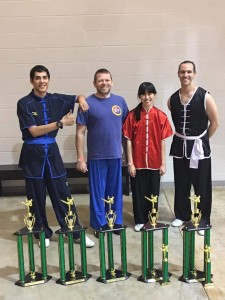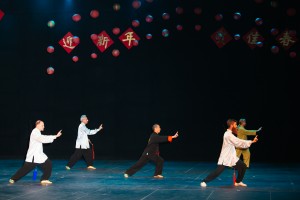Congratulations to the newest members of the U.S. Traditional Wushu Team! After taking several first-place winnings at the National Traditional Wushu Tournament in Lubbock, TX, Asst. Instruction Wade, and students Anthony, Adelynn, Mataya, and John all earned places on the national team. They will be traveling to Ermeishan, China in November to compete at the 7th World Kung Fu Championships!
Author Archives: Xjiard
Chāquán (查拳)

Asst. Instructor Wade, in a xubu stance typical of chaquan.
One of the most influential styles of Chinese martial arts, chá quán (查拳) was developed by the Jiao Men, or Muslim Hui people of Shandong province.
The story goes that a famous Muslim general, Hua Zong Qi, was on a military campaign and was seriously wounded. He was cared for and nursed back to health by the villagers of Xin Jiang. In appreciation for their care of him, he taught them his style of martial arts, jiazi quan. His instruction became so popular that he asked his senior student, Cha Yuan Yi, to come and teach as well. Hua Zong Qi’s style was called dajia quan, or big frame fist, while Cha’s style was known as xiaojia quan, or small frame fist. After their death, their disciples changed the name of their style to Hua Quan and Cha Quan respectively in honor of their teachers.
Hua quan has 4 routines, simply referred to as:
- Yī lu (一路, 1st road)
- Èr lu (二路, 2nd road)
- Sān lu (三路, 3rd road) and
- Sì lu (四路, 4th road)
Cha Quan has ten lu (roads) or routines:
- mu zi (mother and son)
- xing shou (parallel hand movement)
- fei jiao (flying foot)
- sun bin (named for a famous general. Means rising sun)
- quan dong (eastern gate)
- mai fu (ambush tiger)
- mei fa (plum flower)
- lian wuan (continuous)
- long bai wai (dragon shaking tail)
- chuan quan (vertical fist)
The most popular and famous routines are the 4th and 5th lu.
There are three main branches of Cha quan: Zhang, Yang, and Li.
The style is characterized as being open, graceful, clear and concise, continuous, rhythmic and utilizes many hand techniques as well as kicks. Cha quan served as the primary basis for modern changquan and most of the duan compulsory forms take their techniques from Cha Quan.
Double Hook Sword (双鉤, shuāng gōu)
Among the more unique (and rather mysterious) weapons in Chinese martial arts is the hook sword, sometimes called the “tiger head hook” (hǔ tóu gōu, 虎头钩) but most often simply referred to as “double hook” (shuānggōu, 双钩) because they are used in pairs.
Like the straight sword (jiàn, 剑), hook swords are double-edged weapons, with a point below the grip, a large crescent-shaped guard by the grip, and a characteristic hook of the blade at the tip. The earliest examples of this weapon are from the Qing era (1644-1912), making them a relatively new weapon. They are thought to be civilian weapons – never appearing in any of the official listings of Chinese armaments – but surviving sharpened examples indicate some actual use as a weapon. Given their complex construction and the level of required training to use, they were most likely rare.
Unfortunately, beyond what has been found through art and surviving examples, there is little information on the development of this weapon and its various features. Most modern routines are flashy and fluid, and some techniques involve linking the hooked ends to create a single long, flexible weapon.
Oklahoma Spring Break Tournament Success
Congratulations to our Asst. Coach Wade, and students Adelynn, Anthony, and John for their excellent performance at the Oklahoma Spring Break Open Tournament in Cushing, OK on 3/26.
Wade competed in the Black Belt division, winning first place in weapons for his mei hua dao demonstration, and second place in forms for his tai zhu quan.
Adelynn competed in the Junior Black Belt division, where she earned second place in weapons for her long tassel straight sword, and first place in forms for her optional chang quan form.
John won first place in the Intermediate Underbelt divisions for both his chang quan and qiang (spear) forms.
Anthony won first place in the Advanced Underbelt divisions for both his ba ji quan and nan gun (staff) forms.
A great job by our students representing the school well, and demonstrating their hard work. Jaiyou!
- Photo by Elaine Guilloz
- Photo by Elaine Guilloz
- Photo by Elaine Guilloz
2016 CAAT Chinese New Year (Part 2) [Album]
Photos from the 2016 CAAT Chinese New Year Celebration, held at the TCC VanTrease Performing Arts Center. Photos by Kevin Hanna.
2016 CAAT Chinese New Year (Part 1) [Album]
Photos from the 2016 CAAT Chinese New Year Celebration, held at the TCC VanTrease Performing Arts Center. Photos taken by Daniel Madison.
2015 Thanksgiving Celebration [Album]
Photos from the 2015 Thanksgiving Celebration.











